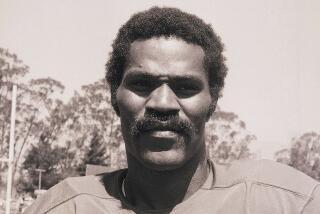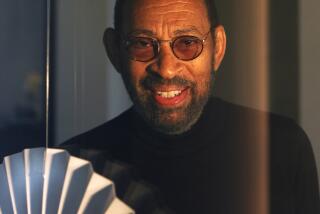BROTHER AND SISTER DUO : FILLMORE DANCERS FIND FAME ABROAD
- Share via
All-American small town kids next door work up a dance act and go off to find fame in the big city. While this sounds like an old-time musical movie plot, it is the real life scenario for Mary and David Johnson, a brother and sister dance duo from Fillmore who traveled to Sweden to find fame.
The pair, popular in Scandinavia for their eclectic blend of American street dance, pantomime, vaudeville and vintage movie routines, is temporarily back for family visits and a series of local performances, the next one on Tuesday at 10:15 a.m. in the Forum at Moorpark College, where they will be the opening act for the school’s 20th anniversary show.
The Johnsons have had to do more than travel to establish themselves as dancers on the European nightclub/television circuit--first they had to learn to dance.
With no formal dance training, Mary, 23, former Fillmore High School cheerleader and “Most Promising Actress,” and David, 26, once a cook at Magic Mountain, have worked nonstop for the last seven years to teach themselves the basics of disco, ballroom, tap, jazz and street dancing. Together they’ve created a dance routine that combines all of the above in a fast-paced kaleidoscopic act, each segment a mini-production number with costumes and music keyed to a storyline.
Those who have seen their routine liken it to the old style novelty acts once so popular here and still in vogue abroad. John Cestare, director of Creative Arts Institute, says, “They’re unique because they’ve created their own classic style and they did it themselves with no help.”
That style has evolved, in part, out of David’s fascination with old musical movies and their legendary dancers--especially, he says, Fred Astaire and Gene Kelly. “Our work is rooted in those movies,” he says. “They’re so perfect they give me fresh inspiration and ideas. Watching them is like a schooling process for me.”
He describes his cassette-age choreographic technique: “We haven’t had time for lessons so we learn from videos of different people’s movies and shows. I try to write down the techniques of what I see--sometimes I use the freeze frame--and then I practice in my studio and adapt those moves to our own style.”
The finished product pays subtle but definite homage to yesterday’s dancing stars. Tall, rangy, loose-limbed but controlled, David often includes a Chaplinesque move here or an Astaire gesture there, and his expressive face is from the Donald O’Connor/Ray Bolger/Dan Dailey mold. When vivacious sister Mary, in pleated dress and bobby sox, joins him for their tap dance/jitter bug number, the old MGM lion seems to stir.
Indeed, their own lives sound Made in Hollywood. Products of a large family, constantly vying for attention with seven siblings and infinite foster children, when the show business bug bit, there was no stopping them. They danced in county fairs, local malls and on “American Bandstand.”
Along the way, David met a pretty Swedish girl and, determined to return to Sweden with her, he danced in Westwood streets to earn air fare. Juliet Prowse, he remembers, gave him $5 and told him to keep dancing.
Once in Sweden, David moved quickly to establish himself as an entertainer. Taking advantage of the Electric Boogaloo craze just beginning in Scandanavia, he took to the streets again, attracting media attention as a new talent, which led to nightclub jobs.
Mary joined him, they refined their act, and with a lot of hard work and some lucky breaks, the good times began for them--bigger club dates, tours and television appearances.
Then, just like in the movies, they got their big chance in the 1985 and 1986 Eurovision song contest, television shows that reportedly reach some 600 million European viewers. By providing backup choreography for the winning singers both years, they were seen by an enormous audience and attained, David says, overnight recognition.
Since that time the Johnsons have made a Norwegian television show about their lives, formed their own promotion company and are booked for months ahead--the traditional Hollywood happy ending. Except this isn’t The End. Now, says David, it’s time for those dance lessons they missed along the way.
“We’re really amateur professionals,” he says, “but now I want to settle down and learn dance techniques from other people. To me, good dance is when each move flows together and you know it’s perfect. Those guys in Hollywood, they knew it all--they were the perfectionists.”
More to Read
Sign up for The Wild
We’ll help you find the best places to hike, bike and run, as well as the perfect silent spots for meditation and yoga.
You may occasionally receive promotional content from the Los Angeles Times.






